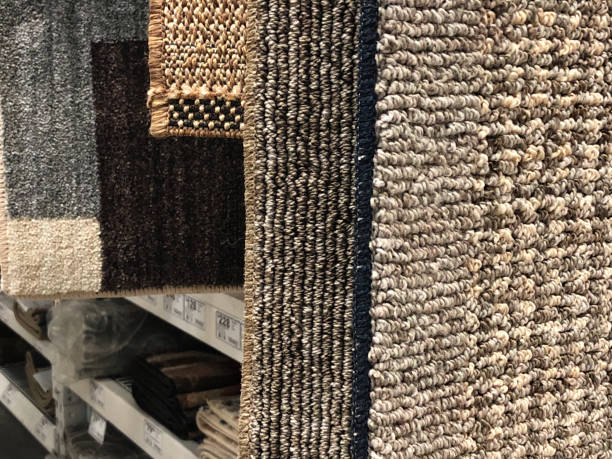Previously, you would go to a carpet store to purchase a new rug. You’re likely to walk away with a rug made of wool.
The best fiber for rugs is wool. Wool is strong, vibrantly dyed, washes beautifully, and lasts forever.
Even the lower-quality wool rugs of a decade back, such as those from China that were heavily processed chemically would still last for decades. The choice was between great investment wool carpets (sold by Rug Galleries) and less-than-great commodity wool carpets (perhaps those sold at Home Depot Expo).
It was still worth having if the wool was good.
It’s a different game today. The market is overflowing with SYNTHETIC rugs.
Synthetic fibers such as olefin, polyester, and acrylic are used to make “FAKE” wool carpets… but, as you can tell, they look like particle board compared to real wood.
Some people might think it’s great that so many synthetic area rugs are available on the market. They would be wrong because low-cost rugs have a higher price that buyers should be aware of.
Because the salespeople aren’t going to tell this.
The pros and cons of today’s SYNTHETIC fiber area rugs
The prices are low.
You are being ripped off if you pay more than 5 dollars per square foot for a synthetic olefin, polyester, or acrylic rug. These rugs should cost you nothing because they are machine-made and have low-quality fibers.
The fact that these rugs are inexpensive is the biggest “pro.”
Cleaning is required MORE often.
Wool fibers are great because they have many “pockets” to hide dirt and grime. They look good when dirty.
This is not the case with plastic fibers like olefin and polyester. These are solid, smooth strands. There is nowhere to “hide,” so soil sticks to the outer fibers. This makes the rugs look duller and ugly. You will need to clean synthetic rugs more often than wool rugs. Synthetic rugs become ugly more quickly.
They can be surface-cleaned with Hot Water Extraction, also known as “steam cleaning,” and cleaned using more aggressive cleaners than wool ones.
The yellowing of the skin is faster.
Plastics do not last long and are not resistant to abrasion. Most wall-to-wall commercial carpet is olefin (because it is CHEAP!) You can see the wear and tear of the carpet in commercial buildings by looking at the high-traffic areas and entryways.
Home improvement stores sell olefin carpet (polypropylene) because it is CHEAP. This is not the best fiber for residential homes as it cannot withstand foot traffic. If you prefer synthetic fibers, choose nylon for wall-to-wall flooring.
After a few years of use, olefin, acrylic, and polyester can become worn.
These are STICKY, and they scratch. Regular vacuum cleaners won’t help.
These cheaper synthetic rugs are difficult to remove lint and hair and can be a pain for owners and professional cleaners.
It is nearly impossible to make these new synthetic shags, sold in stores such as Pottery Barn and look super clean. Professional cleaners must literally “pull” away what washing cannot release row by row. These rugs are also difficult to surface clean with the tools available today. This can result in rugs that cost more than they were originally purchased for. To buy it
If you have a shorter pile of synthetic area rugs, you may be tempted to buy a lint roller to try and roll up the material that sticks to the fibers, but your vacuum cleaner can’t pick it up. You’ll need a lot more lint-roller sheets to do this. =)
Only the Sebo Vacuum Cleaners effectively removes lint, pet hair, and other debris from these rugs. These powerful German-made machines are not cheap but capable of cleaning a rug.
Because they are made of plastic, they aren’t super-soft to the touch. These rugs aren’t very soft, so they aren’t suitable for children to play on.
They are often made of Jute. This is something that PETS owners will not like.
You will not have problems with synthetic rugs if you have poorly trained pets. Although olefin fibers are ugly when dirty, they can be stain-resistant. These plastic fibers, however, are usually wrapped around Jute.
The olefin fibers would have no odor “holding” capacity because they have no “pockets.”
But the Jute? That’s a different story. They are thick, compacted jute fibers that hold odor better than any other fiber. The kings of odor-holding fibers!
If you notice any smells in your synthetic rug, you can choose between two options: either you pay more money to thoroughly wash and clean your rug than you did to purchase it, or you buy another rug and hope your pet doesn’t repeat the issue.
If the synthetic rug is just “dirty,” it can be cleaned using hot water and carpet cleaning chemicals. If there is an ODOR problem, or if the rugs have been exposed to a flood, they should be thoroughly cleaned and deodorized.
It is easy to remove odors from hand-woven rugs. The contaminants left behind by urine or floods can be removed from wool and cotton fiber rugs using a proper washing.
These are petroleum products and, therefore, not sustainable resources.
Plastic fibers are manufactured from petroleum. Some people are unaware that synthetic fibers come from plastic. Some people may not own them for political, environmental, or health reasons.
The best thing about wool is it’s renewable.
It grows back every year and is sheared.

